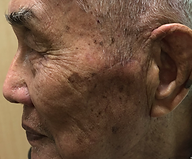
MOHS
Other Surgical Services:
WHAT IS MOHS SURGERY?
MOHS micrographic surgery is a specialised surgical technique primarily used for the treatment of skin cancer.
MOHS surgery is particularly useful for treating skin cancers that are located in areas where preserving healthy tissue is essential, such as the face, ears, or hands. It is also recommended for skin cancers that are large, aggressive, or have recurred after previous treatments.
HOW IT WORKS
MOHS micrographic surgery involves the systematic removal and examination of thin layers of tissue to precisely locate and remove cancerous cells while sparing as much healthy tissue as possible.
It offers the highest cure rates and is especially effective for skin cancers with unclear borders, high recurrence risk, aggressive growth, or those located in sensitive or hard-to-treat areas.
CANCERS TREATED WITH MOHS SURGERY
MOHS Micrographic Surgery is commonly employed to treat two primary types of skin cancer:
Basal Cell Carcinoma (BCC)
The most common type of skin cancer, BCC typically develops on sun-exposed areas.
MOHS surgery is frequently used to treat BCC due to its high cure rate and tissue-sparing precision—ideal for cosmetically sensitive areas or tumors with aggressive characteristics.
Squamous Cell Carcinoma (SCC)
SCC is another common form of skin cancer, often developing on sun-damaged skin or from precancerous lesions like actinic keratoses. Mohs surgery is frequently recommended for high-risk, recurrent, or large tumors, especially those located in delicate or functionally important areas.
**While Mohs surgery offers excellent precision and cure rates, it is not suitable for all cases. Other treatments may be more appropriate depending on the type, stage, and characteristics of the cancer. A dermatologist or surgeon will determine the most effective treatment plan based on each individual case.
MOHS SURGERY PROCEDURE
1
2
3
4
5
6
7
8
MOHS surgery is a specialised surgical technique used to remove skin cancer with high precision. The procedure typically involves the following steps:
Local Anaesthesia
The area is numbed with a local anaesthetic to ensure comfort throughout the procedure.
Removal of Visible Cancer
The surgeon removes the visible tumor along with a small margin of healthy tissue. This initial tissue is examined under a microscope to confirm the cancer type.
Tissue Mapping
The removed tissue is sectioned and carefully mapped to pinpoint any remaining cancer. This map guides the surgeon in precisely targeting additional tissue, if needed.
Layered Tissue Removal
A thin layer of tissue is removed from the area and sent for microscopic examination. This ensures only affected areas are targeted.
Microscopic Examination
A histotechnologist processes and stains the tissue for microscopic analysis to check for remaining cancer cells. This may take up to an hour or more, depending on the sample size.
Repeated Tissue Removal (if needed)
If cancer cells remain, the surgeon removes another layer from the exact area where cancer persists. This process is repeated until no cancer cells are detected, sparing as much healthy tissue as possible.
Wound Closure
Once the cancer is fully removed, the wound is closed with stitches or, if necessary, a skin graft—depending on its size and location. Closure techniques aim to minimise scarring and support healing.
Follow-Up Care
Patients receive detailed aftercare instructions and follow-up appointments to monitor healing and detect any signs of recurrence.
BENEFITS OF MOHS
MOHS surgery offers several benefits over other surgical techniques for the treatment of skin cancer. Some of these benefits include:
High cure rate
MOHS Surgery has a cure rate of over 99% for some types of skin cancer.
Minimised removal of healthy tissue
MOHS surgery is a tissue-sparing technique that is particularly effective when treating skin cancer in cosmetically sensitive areas, such as the face, where the preservation of healthy tissue is crucial for a good cosmetic outcome.
Immediate results
Mohs surgery allows for real-time microscopic examination of tissue during the procedure. This enables the surgeon to immediately confirm whether all cancerous cells have been removed and, if needed, continue treatment on the spot. In most cases, the cancer is fully treated in a single visit—eliminating the need for additional surgeries or waiting for lab results.
Reduced need for extensive skin reconstruction
Because MOHS surgery preserves healthy tissue, it can often reduce the need for extensive reconstruction or skin grafting. This can result in a faster and smoother recovery for the patient.
Effectiveness in treating large or recurrent skin cancers
As the surgeon is able to remove the cancerous tissue layer by layer, they can ensure that all of the cancer cells have been removed, even in cases where the cancer has grown deep or has previously been treated and recurred.
Overall, MOHS surgery is a highly effective, precise, and safe surgical technique that offers several benefits for the treatment of skin cancer.
BEFORE & AFTER
Below shows the process and results of Dr Paul's MOHS work:
Title of type of mole is this

Image contains graphic content,
viewer discretion is advised.
Before

Image contains graphic content,
viewer discretion is advised.
Recovering Process

After
Title of type of mole is this

Before

Recovering Process
Video contains graphic content,
viewer discretion is advised.

After
Description of what type of MOHS surgery is this
Case Studies

.png)